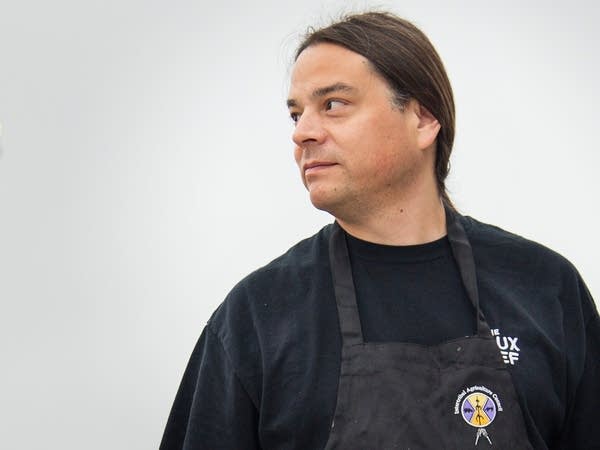'Sioux Chef' revitalizing Native American cuisine

Go Deeper.
Create an account or log in to save stories.
Like this?
Thanks for liking this story! We have added it to a list of your favorite stories.
Sean Sherman is working to help Native Americans reclaim their identity one meal at a time.
The chef, an Oglala Lakota born on South Dakota's Pine Ridge Indian Reservation, embarked on a journey almost a decade ago to revitalize the gastronomy of his culture to bring Native American cuisine to more tables. Now, with a big boost from online fundraising, Sherman is preparing to open a Minneapolis-area restaurant.
"Our foods are our cultural identifier; it's who we are," Sherman said. "We think about the food of our grandparents and our great-grandparents, and those foods are special to us. But for a lot of Native American people, there's been so much death and trauma and oppression that the food systems have taken such a gigantic hit."
The kitchen at a learning center in a Native American neighborhood in Minneapolis bustled Monday as Sherman and his team prepared rabbit, trout and other regional food for donors. He supervised as one chef plated a dish, experimenting with the presentation, while another made cookies. Another chef placed bright orange squash, corn and other vegetables on skewers, as the fragrant smell of toasted amaranth, an ancient grain, wafted through the air.
Turn Up Your Support
MPR News helps you turn down the noise and build shared understanding. Turn up your support for this public resource and keep trusted journalism accessible to all.
Sherman, 42, began working in restaurants when he was 13 in the Black Hills of South Dakota. After moving to Minneapolis, he worked his way up to a chef position, cooking Spanish, French, Japanese and other styles for years. But it was during a stay in a town in Mexico's Pacific coast state of Nayarit in 2007 that he interacted with Huichol Indians and had what he describes as an epiphany.
"I realized I should be focused on foods of my own cultural heritage," Sherman said. "That's what started it, realizing the status of where Native American food was back then and what the future could look like."
He read anthropology, ethnobotanical, history and other books. He talked with elders. He spent time outdoors identifying plants.
"There was no 'Joy of Native American Cooking' cookbook," he joked.
After years of working to identify Lakota flavor, he started a catering business in the Twin Cities in 2014.
Nathan Ratner got to know Sherman that summer while looking for a chef to launch a food truck in Minneapolis. Ratner, then working in economic development for a public housing complex occupied primarily by American Indians, had secured grant money and saw the truck as a way to get job training for residents.
"I interviewed him, asked him to put together a tasting menu. It quickly became clear that he was the choice," Ratner said. Sherman and his team developed the concept and menu for what became the Tatanka Truck — "tatanka" is Lakota for buffalo.
"The word I would use to describe Sean's food is pride," Ratner said. "He takes such pride in his food."

Sherman wound up purchasing the food truck business and has a cookbook due out next fall. But his most ambitious project yet is the restaurant he is working to open in 2017.
He raised nearly $150,000 in a crowdfunding campaign to go toward buying a building for the restaurant that will feature sustainable, organic foods from the region that Native Americans hunted and gathered before processed foods were introduced to their diet. That means no dairy, no flour and no sugar. For protein, he uses venison, bison, and wild birds, and avoids beef, chicken and pork.
Sherman's menus have featured such dishes as maple- and cedar-stewed bison with Native corn and hominy; seared smoked walleye with black bean paste, fried sunchoke crisps and a syrup produced from sumac shrub and rosehip, the fruit of the rose plant; and wild greens with sumac-stewed and sun-dried rabbit.
The restaurant's menu hasn't been determined, but one thing is certain, it won't include fry bread, the high-calorie food associated with Native Americans that many love. The doughy treat was born out of necessity in the 1800s, when the government moved American Indians off their land and gave them rations of flour, salt and lard.
Sherman hopes the restaurant will be a model that could be replicated on a smaller scale or adapted as a deli or grill counter on tribal communities, many of which are in what constitute food deserts or rely on gas stations for food. He also hopes to see indigenous restaurants throughout North America.
"Canada shouldn't be identified by poutine. America shouldn't be identified by Coca-Cola and hamburgers; it should be identified by all of this awesome food and flavor. People need to appreciate the region they're in and the culture that's behind it," Sherman said.


